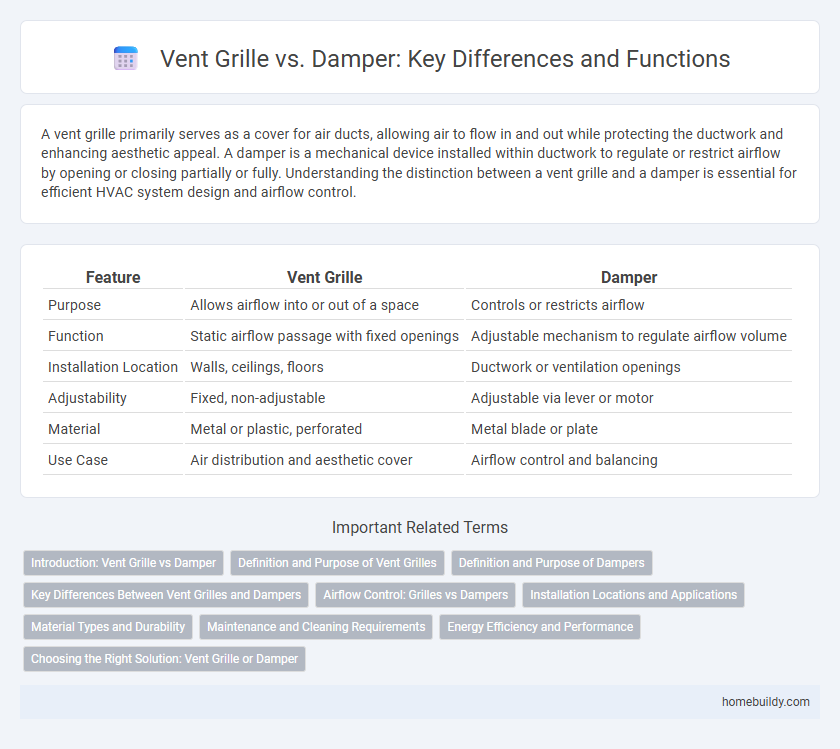A vent grille primarily serves as a cover for air ducts, allowing air to flow in and out while protecting the ductwork and enhancing aesthetic appeal. A damper is a mechanical device installed within ductwork to regulate or restrict airflow by opening or closing partially or fully. Understanding the distinction between a vent grille and a damper is essential for efficient HVAC system design and airflow control.
Table of Comparison
| Feature | Vent Grille | Damper |
|---|---|---|
| Purpose | Allows airflow into or out of a space | Controls or restricts airflow |
| Function | Static airflow passage with fixed openings | Adjustable mechanism to regulate airflow volume |
| Installation Location | Walls, ceilings, floors | Ductwork or ventilation openings |
| Adjustability | Fixed, non-adjustable | Adjustable via lever or motor |
| Material | Metal or plastic, perforated | Metal blade or plate |
| Use Case | Air distribution and aesthetic cover | Airflow control and balancing |
Introduction: Vent Grille vs Damper
A vent grille serves as a cover for air vents, allowing airflow while protecting duct openings, whereas a damper controls or restricts airflow within the duct system. Vent grilles are primarily focused on directing and distributing air, while dampers adjust airflow volume and balance air pressure. Understanding the distinction is essential for HVAC system efficiency and indoor air quality management.
Definition and Purpose of Vent Grilles
Vent grilles are architectural components designed to cover air openings in walls, ceilings, and floors, allowing air to flow freely between spaces while maintaining an aesthetically pleasing appearance. Unlike dampers, which regulate or restrict airflow to control ventilation and pressure, vent grilles primarily serve the purpose of ensuring unobstructed air circulation and preventing debris from entering the duct system. Their design promotes efficient airflow distribution while protecting HVAC equipment and enhancing indoor air quality.
Definition and Purpose of Dampers
Dampers are mechanical devices installed within HVAC ductwork to regulate airflow by opening, closing, or partially obstructing air passages, contrasting with vent grilles that primarily serve as decorative or protective covers for air vents. Their main purpose is to control the volume and direction of airflow, enhancing energy efficiency and indoor comfort. Unlike vent grilles, dampers provide active modulation of ventilation, which can help balance pressure and temperature within building spaces.
Key Differences Between Vent Grilles and Dampers
Vent grilles primarily serve as covers for air ducts, allowing air to flow freely into a room while protecting the duct opening from debris and enhancing aesthetic appeal. Dampers regulate airflow within duct systems by adjusting or completely blocking air movement to maintain desired temperature and pressure levels. Unlike vent grilles, dampers are functional components focused on air control rather than just ventilation and visual protection.
Airflow Control: Grilles vs Dampers
Vent grilles primarily regulate airflow direction and distribution within HVAC systems, ensuring even air circulation across spaces. Dampers provide precise airflow control by adjusting volume or completely shutting off air passages, enabling customized airflow management. Combining grilles with dampers enhances overall airflow efficiency and comfort in ventilation systems.
Installation Locations and Applications
Vent grilles are typically installed in walls, ceilings, or floors to allow air to flow freely while providing aesthetic coverage for duct openings. Dampers, often integrated within ductwork or at vent openings, control airflow by regulating or shutting off air passage, making them ideal for zoning or balancing HVAC systems. While vent grilles primarily serve ventilation and air distribution purposes, dampers offer functional airflow modulation in heating, cooling, and ventilation applications.
Material Types and Durability
Vent grilles are typically made from materials like aluminum, steel, or plastic, offering varying degrees of durability and corrosion resistance suited for different environments. Dampers often incorporate metal components such as galvanized steel or stainless steel to withstand frequent adjustments and maintain airtight control. Choosing between vent grille and damper materials depends on the application's need for robustness, maintenance frequency, and exposure to elements.
Maintenance and Cleaning Requirements
Vent grilles require minimal maintenance, typically involving simple dusting and occasional washing to ensure airflow is unobstructed, whereas dampers demand more frequent inspections and cleaning to prevent mechanical failure and blockage. The complexity of damper mechanisms, such as adjustable blades, increases the risk of accumulation of dust and debris, necessitating regular lubrication and calibration. Proper maintenance of vent grilles prolongs their lifespan and enhances HVAC efficiency, while neglecting damper upkeep can lead to reduced system performance and increased energy costs.
Energy Efficiency and Performance
Vent grilles and dampers play distinct roles in HVAC systems, with vent grilles primarily facilitating airflow distribution while dampers regulate airflow volume and pressure. Incorporating adjustable dampers within vent grilles can enhance energy efficiency by allowing precise control over air distribution, minimizing energy waste and optimizing system performance. Energy savings are maximized when balanced airflow from vent grilles aligns with damper settings, ensuring consistent temperature control and reduced HVAC load.
Choosing the Right Solution: Vent Grille or Damper
Selecting between a vent grille and a damper depends on airflow control needs; vent grilles facilitate air passage while maintaining aesthetic appeal, whereas dampers regulate or restrict airflow within HVAC systems. Vent grilles are ideal for consistent ventilation and distribution, commonly used in residential and commercial spaces to cover duct openings. Dampers provide precise airflow adjustment, essential for balancing HVAC zones and improving energy efficiency in environments requiring targeted climate control.
vent grille vs damper Infographic

 homebuildy.com
homebuildy.com